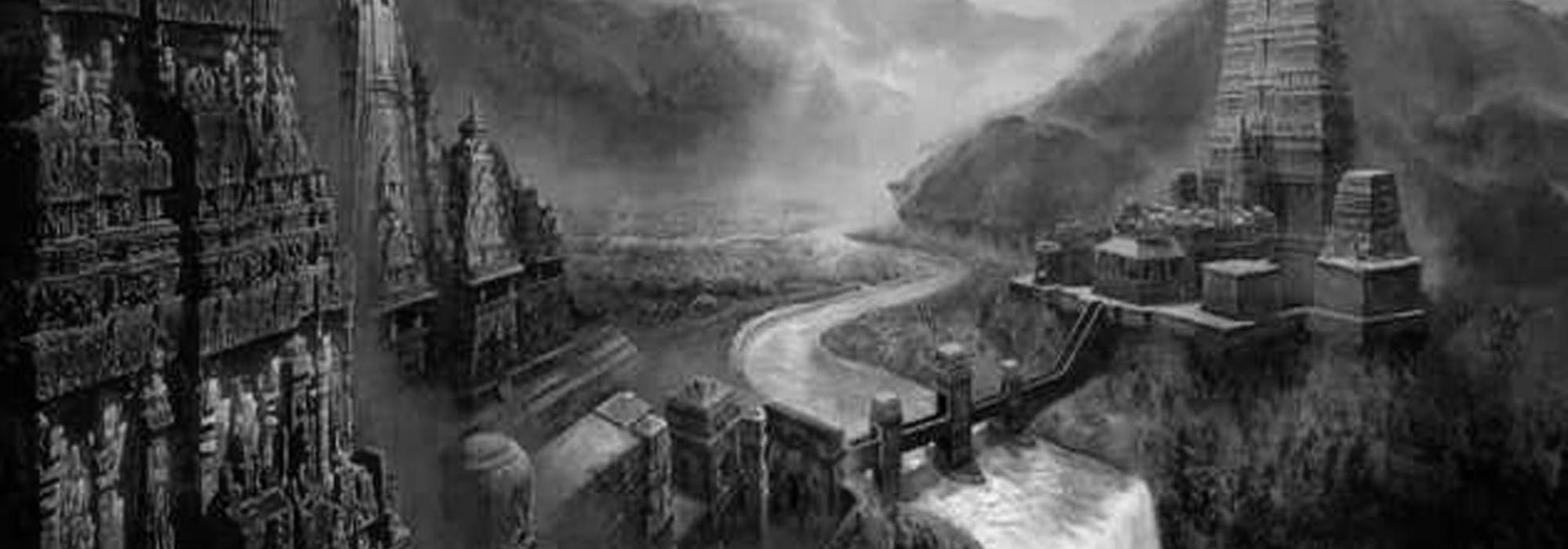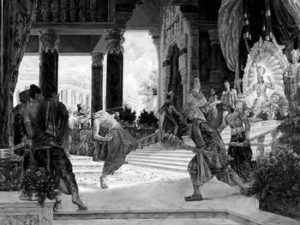Public life is replete with seeming paradoxes. A person closely involved in the public space cannot be hassled by what other people think about him but if someone accuses him of a wrongdoing, he must be capable of clearing his name. After all, his reputation is one of his greatest assets. A classic example in the case of Krishna is the episode of the śyamantakamaṇi. Satrajit’s brother who had been wearing it was found dead. Krishna was accused of theft and murder by Satrajit. He declared that if he did not find the jewel within twenty-one days, he would not return to Dvaraka. Then he set out to find it. He conducted a thorough investigation like a detective, following the chariot tracks, then the pug marks of a lion, which led him to the carcass of a lion. Then he followed the footprints of a bear and landed up at Jambavan’s abode. He recovered the jewel and gave it to Satrajit. When Satrajit begged pardon and offered to give him the jewel, he refused. He said, “It will seem as if I did all this just for the sake of the jewel. I don’t want it. You keep it.” He was least bothered by its value.
Much later, Akrura got hold of the śyamantakamaṇi and had taken it with him to Kashi. Again, Krishna was accused of having it. He went all the way to Kashi where Arkrura was performing a yāga. He asked him to exhibit the jewel to the world. With much hestitation, Akrura took out the jewel and displayed it for everyone to see. Clearing his name a second time, Krishna went back. Such was his determination to clear any accusations against him. A public figure should not let false accusations tarnish his image. He should show the world that he is selfless; it’s not enough if he is selfless but has to get the world to recognize it. It’s easy to demonstrate one’s strength but it’s so difficult to demonstrate one’s selflessness.
Another interesting episode is when Bhishma suggested that the agra-pujā in the Rājāsūya should be offered to Krishna. Shishupala flew into a rage and started abusing Krishna and the others. In response, Krishna stood calmly and request Shishupala to stop. It was only when the yāga was really in danger of getting destroyed and there was no other way out did he step forward and kill Shishupala. While a public figure should develop a thick skin, he should also know when to put an end to a nuisance.
There is an interesting observation in this episode. Shishupala hurls a string of abuses directed at Krishna but he never mentions anything about Krishna being a womanizer or having a weakness for women. Shishupala was someone who hated Krishna and was ready to point out blunders that Krishna had not even done. In such a case, if Krishna was a person of loose character, ogling after women, Shishupala would have definitely added it to his list. But he didn’t. Krishna might have had multiple wives, as was common during his time, but that didn’t affect him or his reputation.
Krishna killed Shishupala when he was trying to destroy the yajña. His act of slicing Shishupala’s head also ended up invoking fear in the hearts of the others, like Duryodhana, who was witness to the event. A public figure has to react at the right time; timing is everything.
What a fine lesson in crisis management we see in Krishna’s life when Arjuna and Duryodhana come to him asking for his help! How does he manage that? Arjuna and Duryodhana are enemies, but they both come to Krishna for help in the war. While Arjuna stands at the foot-side of the bed where Krishna is lying down, Duryodhana sits down at the head-side of the bed. Krishna sees Arjuna first. It is a subtle hint as to who Krishna values more. Yet he agrees to help them both. A public figure has to respect the wishes of people who have come to him with faith and ask for a favour.
Krishna knew that even among the Yadavas, there were people who were against him. Some supported Balarama, some others supported Duryodhana. He told all of them to join the Kauravas under the command of Kritavarma. When there was so much dissent, Krishna felt it was better to allow for the polarization. He sent them all to the enemy’s camp. Better they go to the other side and fight on the battlefield than be inside and create trouble. Do we call this strategy or magnanimity? It is both. Above all, it is an impassionate acceptance of the hard reality. In the end, both Arjuna and Duryodhana went away happy!
As a statesman, how cleverly and elegantly he employed the four upāyas – sāma, dāna, bheda, and daṇḍa. As an emissary of Yudhistira, he first went to the court of Dhritarashtra and asked amicably, “Please give them their rightful share.” That is sāma. When Duryodhana refused, he said, “Don’t give the kingdom, just give them five villages like Indraprastha, Jayantaprastha, and Varanavrata. Let them be in peace.” That is dāna. When that failed, he openly rebuked Bhishma and Drona for siding with adharma and supporting the wicked Duryodhana, thus evoking a dharmic dilemma in their minds. That is bheda. When even that fails, he says, “If you want war, there will be a war.” Daṇḍa.
It is decided that a war will be fought. But even there, just look at his mind. The war was about to start. The gītopadeśa is over. The Pandavas walk barefoot towards Bhishma, Drona, Kripa, and Shalya, and take their blessings. They say, “We are going to attack you in war. Please pardon us. Please give us your blessings.” They reply, “Good. If you did not do so, we would have been upset.” Then they bless them with the words “Vijayī bhava!” Later on, they also tell the Pandavas the secrets of how they can be killed.
Krishna doesn’t go with them. The Pandavas are enough for emotional exploitation. Perhaps the elders may change their minds! Krishna knows that he has other work to do. He goes straight to Karna’s place. Karna has taken a vow that he would not fight the war until Bhishma is the commander-in-chief. He goes up to Karna and says, “Anyway, you’re not going to fight until the fall of Bhishma. Until that time, fight on our side!” Imagine Karna’s mind at that time! Looking at the affectionate invitation, his heart might have melted also. One never knows. What’s the harm in trying? Krishna’s optimism and persistence must have been at such a high level! Whatever possible to the best of his abilities, he did, without ever getting bored or tired.
After they won the war, Yudhistira was to be coronated. At that time, Krishna tells Yudhistira, Bhishma is lying on the bed of arrows waiting for Uttarayana so that he can wish for his death. Krishna didn’t want any learning to go waste. He tells Yudhistira, “We have work to do. The knowledge of an era is within the mind of a man who’s lying on a bed of arrows. Before that fire of knowledge on the bed of arrows fades out, we should go and learn from him.” Bhishma was a great repository of theoretical knowledge on so many topics. Whether or not he practiced that learning, he had amazing knowledge collected over so many years of experience. Krishna makes Yudhistira learn from the grandsire, who shares it all in the Śānti- and Anuśāsana-parvas. Krishna feels that all that knowledge in the hands of Yudhistira might be put to better use. Krishna responded to situations instead of reacting to people.
Krishna cries only once in the entire Mahābhārata. When Duryodhana dies and he sees Dhritarashtra and Gandhari there, he holds their hands and weeps with them. There has been a disaster and they have to cope with it. If Krishna too cries with them, they will find solace. So he cries.
And when Gandhari curses him, he takes it calmly. He tells her, “Your son died because of your arrogance and your jealousy. You cry for the hundred widowed daughters-in-law of yours but what about the hundreds and thousands who became widows because of this war? Well, even my people are not saints. They too will have an end. Your curse will be a witness to that destruction.” Without any feeling of ‘us’ and ‘them’ he did what he had to do.
The Vedas tell us that we should not have any debts. Krishna never left any debts. In the Rāmāvatāra, he hid behind a tree and killed Vāli. That debt was paid in the Kṛṣṇāvatāra when he fell to an arrow that was shot from behind a tree by a hunter hoping to get a meal.
In the Gītā, Krishna says that he is brahman, the all-pervading one. He is the soul of all the animate and the inanimate.
अहमात्मा गुडाकेश
सर्वभूताशयस्थितः।
अहमादिश्च मध्यं च
भूतानामन्त एव च॥
Bhagavad-Gītā 10.20
Therefore, any offering to Krishna is an offering to the all-pervading Supreme being.
Indeed Shiva is Rama, Rama is Krishna and Krishna is Shiva. But when we observe their dominant traits, we find the ideals for individual, family, and society. Their guidance will suffice for a lifetime. May the three – Shiva, Rama, and Krishna – continue to guide us for the years to come!
Concluded.
This serialized article has been translated by Hari Ravikumar from the author’s Kannada lecture held at the Gokhale Institute of Public Affairs, Bangalore in 2009.



















































Comments